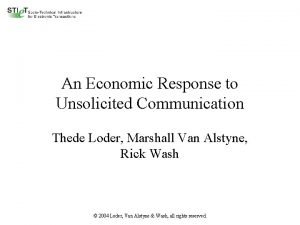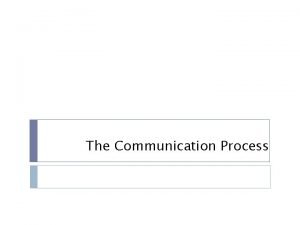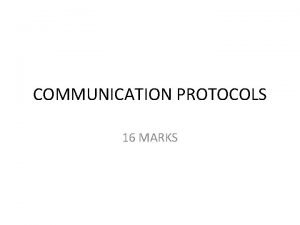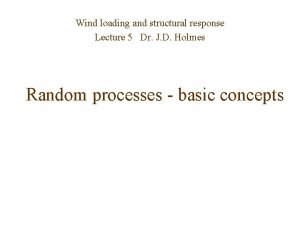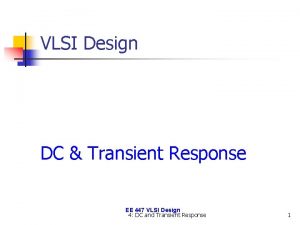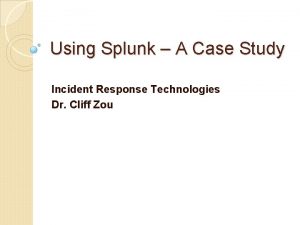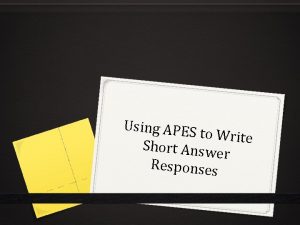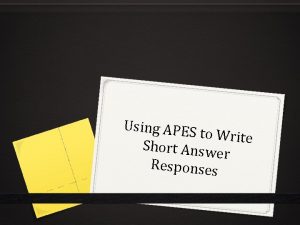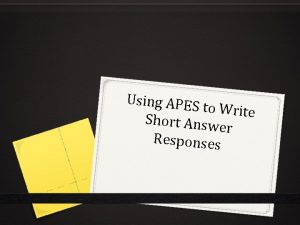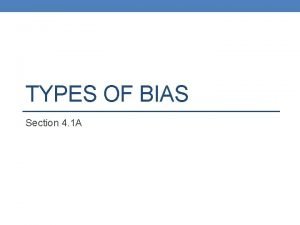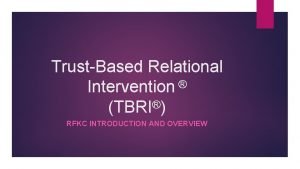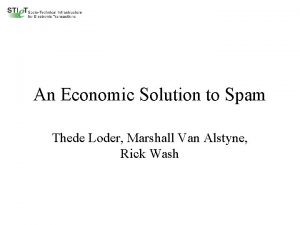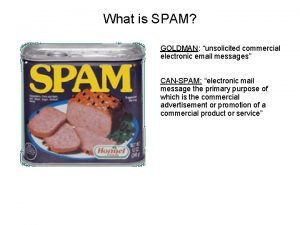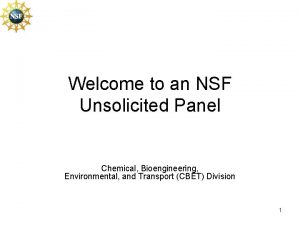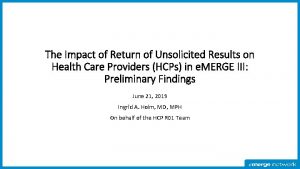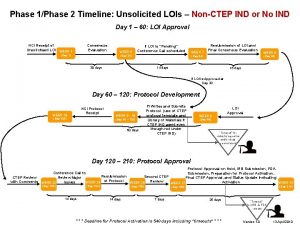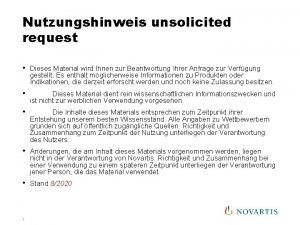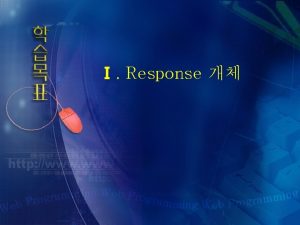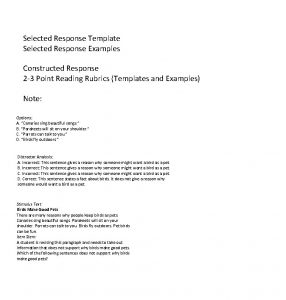An Economic Response to Unsolicited Communication Thede Loder








![Terminology & Assumptions • [r, r] and [s, s] are bounds on reader and Terminology & Assumptions • [r, r] and [s, s] are bounds on reader and](https://slidetodoc.com/presentation_image_h/77725a8f4ff9d0dc45e4abb9cf93444d/image-9.jpg)


































- Slides: 43

An Economic Response to Unsolicited Communication Thede Loder, Marshall Van Alstyne, Rick Wash © 2004 Loder, Van Alstyne & Wash, all rights reserved.

© 2004 Loder, Van Alstyne & Wash, all rights reserved. 2

Data on the Spam Problem • Estimated yearly loss to business $10 billion (Ferris Rsch) • ISPs estimate the cost of spam at $2 -$3 per user per month (IDG) • The Federal ‘Can Spam’ Act passed with near unanimous support; superceding 8 State laws, 6+ spam laws still pending in congress (NYT) • 55% of all email is now spam (Brightmail) • 29% of Americans report curtailing e-mail use (Pew Internet report) Spammer Alan Ralsky vows to carry on (NYT) © 2004 Loder, Van Alstyne & Wash, all rights reserved. 3

Existing or Proposed Solutions • Technological: – Filtering: Rule based (static or dynamic), Naïve Bayesian Filters, collective/community classification – Challenge Response: quasi-Turing tests, return address testing • Legislative/Regulatory: – Banning, labeling – Taxation, stamps • Economic – Computational challenge (proof of work) – Bond © 2004 Loder, Van Alstyne & Wash, all rights reserved. 4

Problems with Legislative Solutions • Defining spam – Whose definition? – One size fits all • Regulating: Banning and labeling – Enforceability, jurisdiction? – Costly to police and adjudicate – Labeling lacks incentive compatibility • Taxing: e-stamps – Blocks wanted along with unwanted email – Blunts cost-effectiveness of email as medium © 2004 Loder, Van Alstyne & Wash, all rights reserved. 5

Problems with Pure Technology Solutions • Filtering (Rules, Collaborative, Bayesian): – – – False positives, false negatives Increases spam email traffic Costly arms-race Consensus definition Blocks automated email • Challenge-Response (Reverse Turing Tests) – Cheaply hire real people – Unrecoverable costs © 2004 Loder, Van Alstyne & Wash, all rights reserved. 6

Beat a Filter with Another Filter berkshire marriott wireless © 2004 John Graham-Cumming “How to beat an Adaptive Spam Filter” 7

Modeling the Message Value • Each message has a party-dependent value: – value to the sender s – value to the recipient r • Range of s and r bounded by r, r, s, s Value to Sender (s) - + s 0 s Value to Recipient (r) - + r 0 © 2004 Loder, Van Alstyne & Wash, all rights reserved. r 8
![Terminology Assumptions r r and s s are bounds on reader and Terminology & Assumptions • [r, r] and [s, s] are bounds on reader and](https://slidetodoc.com/presentation_image_h/77725a8f4ff9d0dc45e4abb9cf93444d/image-9.jpg)
Terminology & Assumptions • [r, r] and [s, s] are bounds on reader and sender values • Sender knows own value s and cost cs before sending, won’t send when s < cs • Recipient only knows her r value after reading and incurring cost cr • Filtering results in a fraction of messages not getting through © 2004 Loder, Van Alstyne & Wash, all rights reserved. 9

Modeling Email Value r s r cs = cost to send cr = cost to receive cr s cs region of positive probability © 2004 Loder, Van Alstyne & Wash, all rights reserved. 10

Modeling Email Value r s r Incentive Compatible for Sender cs = cost to send cr = cost to receive cr s • message is sent when s > cs • sender expects positive payoff r s cs region of positive probability © 2004 Loder, Van Alstyne & Wash, all rights reserved. 11

Modeling Email Value r s r cs = cost to send cr = cost to receive Wanted cr s Examples: - project update from business associate - long lost high school buddy says hi - friend’s wedding announcement - shipping update from ecommerce vendor - recruiting lead from a friend r s cs region of positive probability © 2004 Loder, Van Alstyne & Wash, all rights reserved. 12

Modeling Email Value r s r cs = cost to send cr = cost to receive cr s Unwanted Examples: - offensive pornography - message with attached virus - phishing, Nigerian scam r s cs region of positive probability © 2004 Loder, Van Alstyne & Wash, all rights reserved. 13

Modeling Email Value r s r cs = cost to send cr = cost to receive cr Unsent s • email unsent when s < cs • sender expects negative payoff r s cs region of positive probability © 2004 Loder, Van Alstyne & Wash, all rights reserved. 14

Modeling Email Value r s r cs = cost to send cr = cost to receive Wanted but Not Sent cr s Examples: - personalized loan application - customized news or subscription content - sales leads r s cs region of positive probability © 2004 Loder, Van Alstyne & Wash, all rights reserved. 15

Modeling Email Value r s r cs = cost to send cr = cost to receive cr s Unwanted and Not Sent Examples: - embarrassing news sent to wrong person - outdated or incorrect facts - meaningless details - accidentally telling your boss/advisor what you really think r s cs region of positive probability © 2004 Loder, Van Alstyne & Wash, all rights reserved. 16

Social Welfare Contribution r Welfare (W) = RS + SS cr s Received email northeast of the diagonal line makes a positive contribution to social welfare positive contribution to W negative contribution to W W+ cs © 2004 Loder, Van Alstyne & Wash, all rights reserved. 19

Interpreting Existing Solutions r Solution Sender cost Social cost Flat Tax Per email tax Tax administration E-stamps Per email stamp Stamp creation and collection Computational Challenge Compute cycles Fixed & marginal sunk cost Challenge Response or quasi-Turing Human time, compute time Fixed & marginal sunk cost Criminalizing, Do-Not-Spam list Evasion cost Enforcement Cost loss Wanted cr Unsent s gain cs Unwanted cs+ extra cost W+ © 2004 Loder, Van Alstyne & Wash, all rights reserved. 20

Interpreting Filtering r Good mail blocked Bad mail passed : 0 < < 1 email gets through loss cr Unsent s gain cs Filtered Waste cs/ W+ Sender decision: send when E(gross return) – cost > 0 No filter E(gross return) is s, cost is cs send when s – cs > 0 or s > cs With filter E(gross return) is s, cost is cs send when s – cs > 0 or s > cs/ © 2004 Loder, Van Alstyne & Wash, all rights reserved. 21

Perfect Filter r loss Wanted cr Unsent gain cs Filtered cs/ Definition A technological filter that: § Operates without cost § Makes no mistakes (no false positives, no false negatives) § Intuits and internalizes all reader preferences § Eliminates, prior to receipt, any email where r < cr Not all filtered email is waste! W+ © 2004 Loder, Van Alstyne & Wash, all rights reserved. 22

Consider an “Attention Bond” Initially, the sender knows more about the message than the receiver, so force them to reveal that private knowledge: • • Simple screening mechanism applied to unrecognized senders. Challenge demands an escrowed bond fee of amount . Recipient has sole discretion to claim or return , with expected bond forfeiture b=p. All proceeds b go to recipient. Effects: 1. A recipient-controlled variable ‘tax’ on senders, based on sender behavior and message content 2. Shift task from ex ante classification (hard) to ex post verification (easy). © 2004 Loder, Van Alstyne & Wash, all rights reserved. 23

Recipient Payoff with Bond r For any particular distribution, the recipient can remove the sender incentive to send email. The sender sends when s > cs+p. Any lesser value of s yields a negative expected payoff. Wanted cr s Unsent Unwanted Positive payoff to recipient Negative payoff to recipient W+ cs © 2004 Loder, Van Alstyne & Wash, all rights reserved. 26

Recipient Payoff with Bond r When ( b = p ) > 0, sender costs are cs+p. Increasing p eliminates incentive to send, blocking more of the email in the distribution. Wanted cr -p s Unsent Positive payoff to recipient Unwanted Negative payoff to recipient Now transfer p where p >0, > 0 cs+p © 2004 Loder, Van Alstyne & Wash, all rights reserved. W+ 27

Recipient Payoff with Bond r When ( b = p ) > 0, sender costs are cs+p. Increasing p eliminates incentive to send, blocking more of the email in the distribution. p increasing… Wanted cr -p Unsent Positive payoff to recipient Unwanted Negative payoff to recipient cs+p © 2004 Loder, Van Alstyne & Wash, all rights reserved. W+ 28

Recipient Payoff with Bond r When ( b = p ) > 0, sender costs are cs+p. Increasing p eliminates incentive to send, blocking more of the email in the distribution. p increasing… Wanted scr -p Unsent Positive payoff to recipient Unwanted Negative payoff to recipient cs+p © 2004 Loder, Van Alstyne & Wash, all rights reserved. W+ 29

Recipient Payoff with Bond r When ( b = p ) > 0, sender costs are cs+p. Increasing p eliminates incentive to send, blocking more of the email in the distribution. p increasing… Wanted s Unsent cr -p Positive payoff to recipient Unwanted Negative payoff to recipient cs+p © 2004 Loder, Van Alstyne & Wash, all rights reserved. W+ 30

Recipient Payoff with Bond r When ( b = p ) > 0, sender costs are cs+p. Increasing p eliminates incentive to send, blocking more of the email in the distribution. Wanted s Unsent cr -p Positive payoff to recipient Negative payoff to recipient Unwanted cs+p © 2004 Loder, Van Alstyne & Wash, all rights reserved. W+ 31

Recipient Payoff with Bond r When ( b = p ) > 0, sender costs are cs+p. Increasing p eliminates incentive to send, blocking more of the email in the distribution. Wanted s Unsent cr -p Positive payoff to recipient Negative payoff to recipient Unwanted cs+p © 2004 Loder, Van Alstyne & Wash, all rights reserved. W+ 32

Recipient Payoff with Bond r When ( b = p ) > 0, sender costs are cs+p. Increasing p eliminates incentive to send, blocking more of the email in the distribution. Unsent Wanted cr -p Positive payoff to recipient Negative payoff to recipient Unwanted cs+p © 2004 Loder, Van Alstyne & Wash, all rights reserved. s W+ 33

Recipient Payoff with Bond r When ( b = p ) > 0, sender costs are cs+p. Increasing p eliminates incentive to send, blocking more of the email in the distribution. Unsent Wanted Positive payoff to recipient Negative payoff to recipient cr -p Unwanted cs+p © 2004 Loder, Van Alstyne & Wash, all rights reserved. s W+ 34

So why not just seize the bond all the time? © 2004 Loder, Van Alstyne & Wash, all rights reserved.

Comparison of Bond to Perfect Filter • • G distribution expected to be mostly ‘Good’ B distribution expected to be mostly ‘Bad’ Sender does not know r Sender knows to which distribution (G or B) his email belongs • Bond size is the same for both distributions © 2004 Loder, Van Alstyne & Wash, all rights reserved. 36

Bond permits discriminatory costs • More costly for spammers due to being collected more often © 2004 Loder, Van Alstyne & Wash, all rights reserved. 37

Distribution G r “Good” G cr s W+ cs © 2004 Loder, Van Alstyne & Wash, all rights reserved. 38

Distribution B r cr B s “Bad” W+ cs © 2004 Loder, Van Alstyne & Wash, all rights reserved. 39

G Sent with Attention Bond r Unsent G G cr s For each distribution, the recipient can choose a policy with a seize probability px W+ cs cs + pg © 2004 Loder, Van Alstyne & Wash, all rights reserved. 40

B Sent with Attention Bond r cr Unsent B B For a mostly unwanted email distribution, the recipient is best off if they seize with a high probability (expected bond size b = p is large) s W+ cs cs + pb © 2004 Loder, Van Alstyne & Wash, all rights reserved. 41

Welfare Basis - Attention Bond r G cr B cs + pb cs + pg s W+ cs © 2004 Loder, Van Alstyne & Wash, all rights reserved. 42

Welfare Basis - Perfect Filter r G B Sent & Filtered cr s Sent & Filtered c s / g c s / b W+ cs © 2004 Loder, Van Alstyne & Wash, all rights reserved. 43

The ABM in Action $$ A A N A M C MC MM Sender initiates server attempts amail message delivery Recipient’s Sender or. The …and the Sender Recipient not challenge mail Escrow Sender Mail onmail on server The whitelist, Whitelist, Server issues claims is issues bond delivered issues notification delivers bond-challenge bond posted bond to or authorization delivered original the authorization lets of Sender… it bond expire. issued message receipt The bond isis returned 44 © 2004 Loder, Van Alstyne & Wash, all rights reserved.

Architecture for ABM © 2004 Loder, Van Alstyne & Wash, all rights reserved. 45

Additional Social Benefits • Direct marketing – Cheaper than traditional mail channels – Receiver gets the benefit, not printer and mailer – Costs less than snail-mail • • • Recipients have reason to publish contact information, not hide it Shifts arms race to crypto. Permits communication otherwise filtered (e. g. political speech) Tailors to an individual’s unique preferences. Reclaims the value of your address for you rather than the marketers. Helps you get off any list you don’t want to be on. © 2004 Loder, Van Alstyne & Wash, all rights reserved. 46

Conclusion • Screening action of bond forces senders to reveal their intentions • Creates possibility of greater trade volume, with both parties wanting to participate • Facilitates wealth transfers benefits readers more than unilateral veto. Can beat a Perfect Filter. • Shifts the arms-race to crypto • Individualized, works with existing uses • Returns control of the mailbox to its owner © 2004 Loder, Van Alstyne & Wash, all rights reserved. 47
 Unsent message to aydin
Unsent message to aydin Unsolicited trade
Unsolicited trade Unsolicited recommendation letter
Unsolicited recommendation letter Apa yang dimaksud dengan solicited dan unsolicited proposal
Apa yang dimaksud dengan solicited dan unsolicited proposal Natural and forced response
Natural and forced response Natural response and forced response example
Natural response and forced response example A subsequent
A subsequent Economic growth vs economic development
Economic growth vs economic development Economic growth and development
Economic growth and development Chapter 1 lesson 2 our economic choices worksheet answers
Chapter 1 lesson 2 our economic choices worksheet answers All response hierarchy models of the communication process
All response hierarchy models of the communication process Serial parallel communication
Serial parallel communication What is oral communication and written communication
What is oral communication and written communication Serial communication and parallel communication
Serial communication and parallel communication Types of nonverbal communication chronemics
Types of nonverbal communication chronemics Definition of oral communication
Definition of oral communication Serial communication vs parallel communication
Serial communication vs parallel communication Disaster response curve park model
Disaster response curve park model What is the purpose of a response to literature essay
What is the purpose of a response to literature essay How to close a professional email
How to close a professional email What is a creative response
What is a creative response Load response correlation
Load response correlation Transient response in vlsi
Transient response in vlsi Visual reflection pictures
Visual reflection pictures Incident-response-technologies
Incident-response-technologies Interactive voice response system randomization
Interactive voice response system randomization Apes paragraph example
Apes paragraph example Apes response
Apes response Apes response
Apes response What is non response bias
What is non response bias Turning point audience response system
Turning point audience response system Tbri levels of response
Tbri levels of response Triple response histamine
Triple response histamine Total physical response method
Total physical response method Park model hazards
Park model hazards How to write an extended response
How to write an extended response Srrt team
Srrt team Reader response journal prompts
Reader response journal prompts Modal action patterns
Modal action patterns Extended response examples
Extended response examples Total physical response storytelling
Total physical response storytelling Response essay example
Response essay example Christian response to suffering
Christian response to suffering Relaxation response technique
Relaxation response technique
